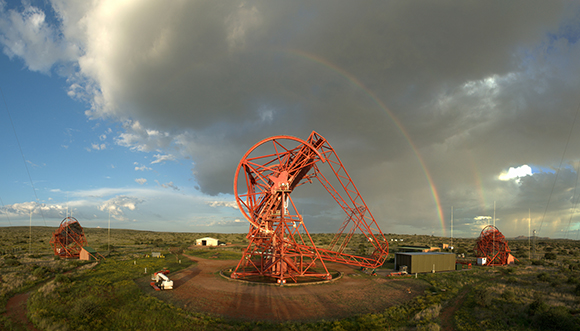Menu
Rechercher
Accueil > Rayonnement Cosmique et Matière Noire > H.E.S.S. > H.E.S.S.
H.E.S.S.
by Julien Bolmont - 12 May 2022

Ground-based gamma astronomy covers a wide range in energy from a few tens of GeV to nearly a hundred TeV. This research area aims to understand the mechanisms of particle production and acceleration in sources such as supernovae, pulsars or active galaxy nuclei. It is also dealing with particle physics topics such as the search for dark matter, which represents a fourth of the content of the Universe, or the study of different galactic and extragalactic diffuse emissions. Finally, fundamental laws, such as relativistic invariance, are tested.
For more than thirty years, the laboratory has been involved in this research through the THEMISTOCLE, CAT and now HESS experiments. The LPNHE team is strongly involved in the construction of these facilities, their maintenance and calibration, the development of analysis techniques, the simulation of events and in the three research themes presented above. Finally, the CTA project, in which the laboratory plays a major role, will offer new opportunities for discoveries.
The HESS experiment, installed in Namibia, has been collecting data with four large telescopes since the end of 2003. It entered a second phase of operation in 2012 with the addition of a fifth very large telescope at centre of the previous array. A large number of high energy (TeV) gamma ray sources are detected each year. With the accumulation of great statistics and high resolution cameras, high-energy gamma astronomy has entered a new era. Let’s mention some highlights:
- The measurement of the density of the extragalactic infrared background emission;
- The detection of the first periodic source, the first radiogalaxy and stat burst galaxy at TeV;
- The reconstruction of the morphology of multiple galactic astrophysical objects and the one of the first extragalactic extended source;
- The determination of the energy spectrum of iron radiation from about 10 TeV to about 200 TeV and the reconstruction of diffuse electron emissions up to 20 TeV;
- The derivation of strong constraints on the mechanisms of cosmic ray acceleration by the explosion of supernovae or the jets produced by the active nuclei of distant galaxies;
- The revelation of galactic cosmic radiation in the PeV energy domain
- Strong limits on Lorentz invariance violation, dark matter search, or extragalactic diffuse gamma emissions;
- The reconstruction of the largest field of view of the central plane of our Milky Way and the revelation, within it, of a diffuse emission of gamma rays;
- The spatial extension of the emission of the Crab Nebula.
The Descartes prize for research was awarded to the HESS collaboration by the European Commission in 2006. That same year, the experiment was ranked among the ten observatories with the largest scientific impacts worldwide, such as the Hubble Space Telescope and the ESO observatory in Chile. More recently, in 2010, the HESS experiment was nominated by the American Society of Astronomy for the prestigious Rossi Award.
Contact : Julien Bolmont - Tel : +33 1 44 27 48 18
Image credits: ©J. Bolmont
Also in this section :









